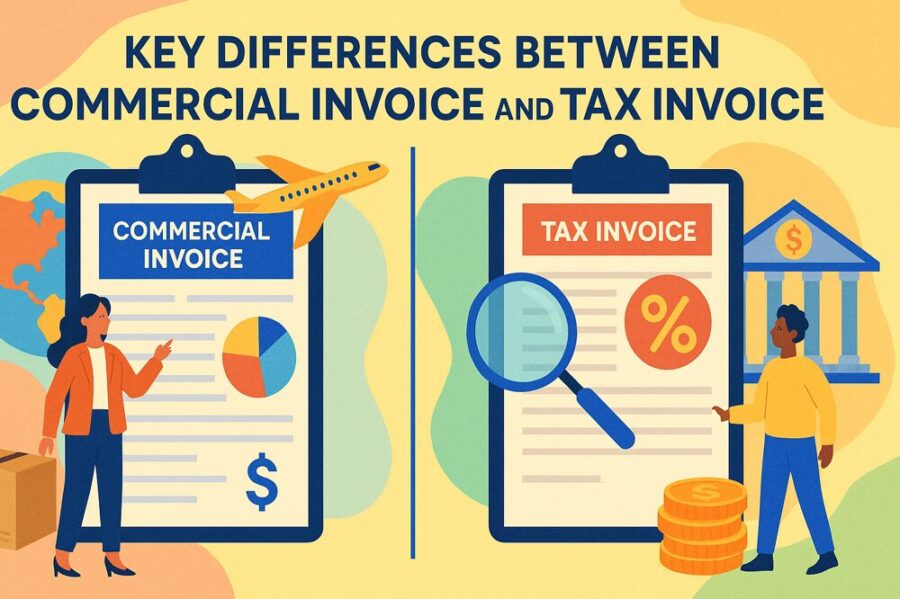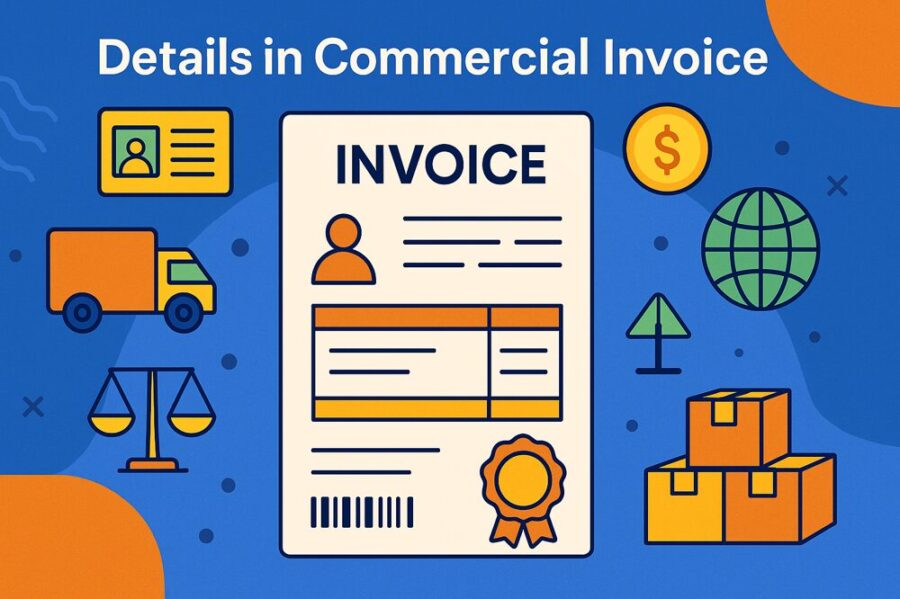What is The Difference Between Commercial Invoice and Tax Invoice
- 4 Nov 25
- 8 mins

What is The Difference Between Commercial Invoice and Tax Invoice
- A Quick Overview of the Key Differences Between Commercial Invoice and Tax Invoice
- A Detailed Comparison of Commercial Invoice vs Tax Invoice
- What is a Commercial Invoice?
- Details in Commercial Invoice
- 5 Ways in Which Commercial Invoices Help in International Trade
- What is a Tax Invoice?
- Details Included in a Tax Invoice
- How to Issue a Tax Invoice?
- Conclusion
Key Takeaways
- A commercial invoice facilitates international trade and customs clearance, while a tax invoice ensures domestic tax compliance under GST regulations.
- Commercial invoices are audited by customs authorities, whereas tax invoices are audited by the Commissioner of CGST/SGST or other authorized officers.
- A commercial invoice must be raised on or before goods dispatch, while a tax invoice must be issued within 30 days (for services) and 45 days (for banks/insurers).
- Commercial invoices emphasize trade, shipment, and customs details such as freight and country of origin.
- Tax invoices focus on taxable value, GST rate, and input tax credit details.
- Both documents enhance business operations, commercial invoices aid international logistics, while tax invoices ensure legal compliance and transparency in taxation.
Did you know that a commercial invoice is primarily audited by customs authorities, whereas a tax invoice is primarily audited by the Commissioner of CGST/SGST? Out of many invoices, commercial and tax invoices also have their share of differences.
These differences include their primary purpose, time limit of issuance, practical implications and more. For instance, the time limit for issuance of a commercial invoice is by dispatch and for a tax invoice is within 30 days for services, 45 days for banks or insurers.
Keep reading to clarify the difference between commercial invoice and tax invoice.
A Quick Overview of the Key Differences Between Commercial Invoice and Tax Invoice

| Factor | Commercial Invoice | Tax Invoice |
| Usage and Purpose | Needed for the import and export clearance process | Used for tax compliance and meeting tax obligations. |
| Included Information | Focus on business transaction specifications | Highlights the involved taxes and their breakdown for financial monitoring by tax authorities and businesses |
| Time Limit to Issue | Raised on or before the products are transported from the supplier’s location to the buyer | After the supply in case of services and on or before in case of goods |
| Operational Efficiency | Streamlines daily transactions for smoother trade | Enhances transparency by providing tax obligation records and preventing legal issues |
| Practical Implications | Help in maintaining financial records and expense tracking | Helps companies to accurately report taxes |
| Audited By | Customs authorities | The Commissioner of CGST/SGST or any authorised officer by them |
A Detailed Comparison of Commercial Invoice vs Tax Invoice
Usage and Purpose
The primary uses of a commercial invoice include compliance with trade laws, both National and international and its ability to facilitate shipping and logistics for a company. Commercial invoices play a very important role in the import and export process of sold goods all over the world.
On the other hand, the primary purpose of a tax invoice is to help a business comply with national tax regulations. In processes such as claiming input tax credit, acting as a legal proof of sales transactions, dispute resolution between buyers and sellers, and creating a viable audit trail for the Indian tax authorities, a tax invoice plays a very prominent role.
Included Information
A commercial invoice primarily includes details related to customs trade for international shipments. These details can include the quantity of goods, the origin country for the product shipment terms and other applicable charges such as freight, insurance, and more.
On the other hand, a tax invoice primarily focuses on taxation details for domestic tax authorities. Details for GST complaints in India might include the description of goods and the taxable rate of the goods or services.
Time Limit to Issue
When goods are moved, the supplier must issue the commercial invoice on or before removing them for delivery to the buyer. In simple terms, the invoice should be prepared no later than the dispatch date.
On the other hand, a tax invoice must be issued within a set time frame, which differs for goods and services. For goods moved between locations, the supplier must issue them on or before dispatch. If there is no movement, it should be issued when the goods are handed to the buyer. For services, the invoice must be issued within 30 days, while banks and insurance companies have up to 45 days.
What is a Commercial Invoice?
A commercial invoice refers to an export document which acts as legal evidence of any sales transaction between the seller and the buyer. In India, the CBIC mandates the submission of certain documents for import and export procedures, including the commercial invoice.
According to Circular No. 01/15-Customs, a commercial invoice cum packing list meets customs requirements for proper import or export, as both documents contain similar fields. Under the Foreign Trade Policy, importers and exporters must submit an airway bill or bill of lading, a commercial invoice cum packing list and a shipping bill.
For international shipments, exporters usually prepare at least 3 copies of a commercial invoice, one for themselves, one for the importer and one for customs authorities.
Details in Commercial Invoice

There are primarily 3 categories of details that a commercial invoice has, which include buyer and seller information, transaction information and shipping information. Under these categories are the specific data that a seller needs to include in the commercial invoice:
Buyer and Seller Information
- Name of the buyer and seller
- Address of the buyer and seller
- Tax information of the buyer and seller
- Contact details of the buyer and seller
Transaction Information
- Invoice number
- Invoice date
- Goods description
- Order number
- Payment mode
- Value and quantity of goods
- Origin country
- GSTIN and IEC Code
Shipping Information
- Export route
- Freight charges
- Gross weight
- Shipment date
- Insurance charges
- Number of packages
5 Ways in Which Commercial Invoices Help in International Trade
- Engage in International Trade
Businesses create a commercial invoice when they trade goods internationally, as it becomes a key document for cross-border transactions.
- Provide Details for Customs
Customs officials use the commercial invoice to calculate duties and taxes on imported goods accurately.
- Act as a Product Passport
The commercial invoice works like a passport for products, allowing goods to pass through borders without unnecessary delays.
- Ensure Smooth Customs Clearance
By preparing the commercial invoice correctly, businesses enable their products to move seamlessly between countries.
- Support Successful Delivery
A complete and accurate commercial invoice acts as the ideal travel companion for the shipment, ensuring it reaches its destination without complications.
What is a Tax Invoice?

A tax invoice is a document that every registered taxpayer must provide to their customers. This document lists the goods supplied, their quantity, applicable taxes and the taxable amount. It serves as the main proof that allows buyers to claim input tax credit.
Under Section 31 of the CGST Act, all registered suppliers are obligated to issue a tax invoice for each supply of goods or services. When the supplier is not registered, the responsibility shifts to the buyer, who must prepare both a payment voucher and a tax invoice.
💡If you want to streamline your payment and make GST payments via credit, debit card or UPI, consider using the PICE App. Explore the PICE App today and take your business to new heights.
Details Included in a Tax Invoice
- Contact and name of supplier
- Contact and name of customer
- Tax invoice number
- Customer’s and supplier’s GSTIN and PAN
- Invoice issue date
- Place of goods supply
- Tax amount, HSN code and tax rate
- Sold goods description
- Taxable amount and sold goods’ gross value
- Discount (if any)
- RCM applicability
- Signature of authorised representative or supplier
How to Issue a Tax Invoice?
To issue a tax invoice, the issuer needs to make 3 copies if they are for a goods transaction and 2 copies if they are for a services transaction.
For goods
- First Copy: Given to the buyer, marked ‘original for recipient’
- Second Copy: Given to the transporter, marked ‘duplicate for transporter’ and shown as proof during transit
- Third Copy: Kept by the supplier, marked ‘triplicate for supplier’
For services
- First Copy: Sent to the buyer, marked ‘original for recipient’
- Second Copy: Retained by the supplier, marked ‘duplicate for supplier’
Conclusion
While both documents are essential for smooth business operations, their roles differ significantly. A commercial invoice focuses on international trade compliance, ensuring goods pass customs without delays. In contrast, a tax invoice centres on GST compliance, enabling accurate tax reporting and input tax credit claims in India. Therefore, knowing the difference between commercial invoice and tax invoice not only helps businesses stay legally compliant but also streamlines transactions, reduces errors and safeguards financial records.

















